Low-Dimensional Materials and Related Heterostructures: Promises for Next-Generation Optoelectronic & Electrical Devices
A special issue of Micromachines (ISSN 2072-666X). This special issue belongs to the section "D:Materials and Processing".
Deadline for manuscript submissions: closed (31 October 2023) | Viewed by 1842
Special Issue Editors
Interests: computational materials and physics; excited-state MD; light-matter interaction; optoelectronic materials and devices; optical crystals
Special Issues, Collections and Topics in MDPI journals
Interests: computational physics and chemistry; 2D materials and heterostructures; electronic and optoelectronic devices; energy materials; cluster science
Special Issues, Collections and Topics in MDPI journals
Special Issue Information
Dear Colleagues,
With the development of integrated circuits according to Moore’s law, traditional silicon-based devices have gradually reached their performance limitation. Thus, we need to explore the new channel for future optoelectronic and electrical devices by using novel low-dimensional materials and heterostructures, in combination with photon-electron fusion technology. Low-dimensional (D) materials, including 0D, 1D, and 2D materials and their hybrid heterostructures, have been increasingly attracting interest due to their unique optical, magnetic, dielectric, electrical, and optoelectronic properties. In addition, the electronic structures and optical properties of low-dimensional materials could be easily modulated by adjusting the chemical compositions, stacking order, external electric/magnetic field, light, doping, substrates, etc. However, theoretical and experimental studies on electronic, optical and magnetic properties for those low-dimensional hybrid materials have not been sufficiently explored yet. Particularly, thorough theoretical insights into the light-induced non-equilibrium processes and physical figures of the dynamics between photon, electron, spin, and phonon are still lacking. Anyway, these novel nanomaterials and techniques have been becoming a hot research topic for next-generation optoelectronic and electronic devices.
In this Special Issue, we encourage submissions from researchers who are working on computational, theoretical and experimental studies of novel low-dimensional materials for optoelectronic and electronic devices, ranging from materials synthesis and characterization, and device fabrications to optoelectronic and electromagnetic simulations (multi-scale computational simulations) and thermal management. Important topics of growing interest are the 0 dimensional (0D), 1D, and 2D materials/heterostructures with promises for next-generation optoelectronic and electronic devices where we can see rapid development, and we invite such topics for inclusion in this Special Issue.
Prof. Dr. Liujiang Zhou
Dr. Guangzhao Wang
Dr. Junjie He
Guest Editors
Manuscript Submission Information
Manuscripts should be submitted online at www.mdpi.com by registering and logging in to this website. Once you are registered, click here to go to the submission form. Manuscripts can be submitted until the deadline. All submissions that pass pre-check are peer-reviewed. Accepted papers will be published continuously in the journal (as soon as accepted) and will be listed together on the special issue website. Research articles, review articles as well as communications are invited. For planned papers, a title and short abstract (about 100 words) can be sent to the Editorial Office for announcement on this website.
Submitted manuscripts should not have been published previously, nor be under consideration for publication elsewhere (except conference proceedings papers). All manuscripts are thoroughly refereed through a single-blind peer-review process. A guide for authors and other relevant information for submission of manuscripts is available on the Instructions for Authors page. Micromachines is an international peer-reviewed open access monthly journal published by MDPI.
Please visit the Instructions for Authors page before submitting a manuscript. The Article Processing Charge (APC) for publication in this open access journal is 2600 CHF (Swiss Francs). Submitted papers should be well formatted and use good English. Authors may use MDPI's English editing service prior to publication or during author revisions.
Keywords
- low-dimensional materials
- two-dimensional materials
- dynamics
- optoelectronic and electronic devices
- multi-scale simulations








